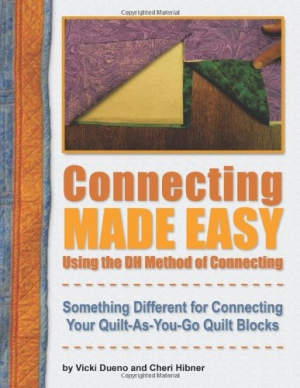
Connecting Made Easy Using the DH Method of Connecting
Something Different for Connecting Your Quilt-as-You-Go Quilt Blocks
This new book and method of quilt-as-you-go should prove popular with quilting enthusiasts and crafters.
Sisters Vicki Dueno and Cheri Hibner have taken their love for quilting and experimentation and come up with a new quilt-as-you-go system, which they outline in Connecting Made Easy Using the DH Method of Connecting. Their system of machine quilting is billed as being both less wasteful with fabrics and easy to learn; it doesn’t require a long-arm sewing machine and allows quilters to easily make two-sided quilts. The DH connectors (presumably named after the authors’ surname initials) are made in long sections and attached to the quilt blocks in precisely ordered ways to achieve the stated benefits.
The first half of the book provides step-by-step instruction for making a two-sided lap quilt and is geared toward the novice, though readers are presumed to be experienced sewers, familiar with various sewing terms and techniques that are not explained here. Dueno and Hibner present detailed explanations about planning and sketching out ideas for patterns, making and attaching the quilt blocks and connectors, and binding and finishing. Their conversational style is easy to follow, and the pair generously offers many helpful time-saving tips and ideas, such as making one’s own quilt templates and bindings as well as pressing seams. They also demonstrate the effects of different machine quilting styles and thread colors, so beginners can better comprehend their quilt design options.
Advanced quilters can jump ahead to later chapters, which explain the DH connector process for larger two-sided quilts. These pages also provide careful instructions and inventory lists for making quilts that can be adjusted to fit various bed sizes.
The book is amply illustrated with photos and illustrations for each step. The visuals are large and annotated with arrows and numbers to give an expanded view of how the quilt layers come together with the authors’ innovative system. The illustrations could be sharper, but the overall design of this how-to book is clean, uncrowded, and easy to understand. The larger softcover format, charmingly designed to look like a quilt on the covers, makes it easy for crafters to reference the book as they are working on the various stages of their quilt.
The authors use a conversational tone, effective in guiding readers through what could be an overwhelming project. There is comfort in reading that the authors are “by no means expert quilters,” even as their photographed examples show beautiful finished quilts. However, the narration sometimes slips from “I” to “we,” and there are enough spelling and grammatical errors and awkward phrasing to make the instructions less clear. For example: “Or simply the beautiful material that you couldn’t resist but know that it will make the most beautiful quilt, the design you know will come later.”
This book and its quilt-as-you-go system should prove popular with quilting enthusiasts and crafters, be they novices or veterans who want to try out a new method.
Reviewed by
Rachel Jagareski
Disclosure: This article is not an endorsement, but a review. The publisher of this book provided free copies of the book and paid a small fee to have their book reviewed by a professional reviewer. Foreword Reviews and Clarion Reviews make no guarantee that the publisher will receive a positive review. Foreword Magazine, Inc. is disclosing this in accordance with the Federal Trade Commission’s 16 CFR, Part 255.
